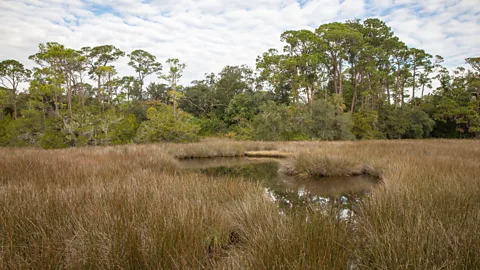Fort Mose: The first free Black town in the US
 Allen Creative/Steve Allen/Alamy
Allen Creative/Steve Allen/AlamyNearly 200 years before slavery was abolished in the US, Black freedom-seekers journeyed south instead of north to a place that promised freedom.
In October 1687, a dugout canoe arrived at the shores of St Augustine, then a settlement in Spanish Florida and now the oldest continuously occupied city in the mainland US. The canoe carried eight men and two women, one of whom was holding a toddler in her arms. The travellers were Black fugitives who had escaped enslavement by British plantation owners in the Carolinas to the north. After disembarking from their vessel, they headed to the town centre in search of freedom.
"They went to present themselves to the governor of St Augustine," said Jane Landers, a professor of history at Vanderbilt University and a director of Slave Societies Digital Archive, which documents the history of enslaved Africans and their descendants. "They explained that they are asking for his protection, and that they wanted to become Catholics."
The group of travellers had heard that this Spanish settlement was set to become a religious sanctuary and would offer freedom to any previously enslaved person willing to convert to Catholicism. Soon, other enslaved Black people from Georgia and the Carolinas in British Colonies up north began to escape south to St Augustine.
The journey toward freedom could take a week or more and was perilous. The escapees navigated swamps and coastal waters that were full of dangers. In the wilderness, alligators, panthers and poisonous snakes awaited. In towns and villages, slave catchers prowled the streets. The sun was relentless, as were the mosquitos, and it was often difficult to find food and water. Still, for many, the promise of freedom was worth the risk. Sometimes, the local Yamassee Native Americans who lived in Georgia and the Carolinas even helped the fugitives, essentially creating an early Underground Railroad that ran south instead of north.
 Linda Burek/Alamy
Linda Burek/AlamyThese original 10 canoe-bound travellers were the first documented religious asylum-seekers to St Augustine, and unbeknownst to them at the time, they laid the foundation for a more just and egalitarian society. For the next 76 years that followed, a small community of formerly enslaved African Americans lived as free people in St Augustine, transforming it into a town that was dramatically different than anywhere else in the American South.
Unlike the system of race-based chattel slavery employed in the British Colonies, Spain viewed the institution of slavery differently. It followed the old Roman law, in which anyone – regardless of skin colour – could be enslaved if they had been condemned or captured in wars. Yet, under this Castilian code, enslaved people had certain rights and protections, such as the right to be treated humanely and the right to become free either by military service or by converting to Catholicism. Spanish slave owners were also not allowed to break apart families or sell children away from their parents.
Rediscovering America
Rediscovering America is a BBC Travel series that tells the inspiring stories of forgotten, overlooked or misunderstood aspects of the US, flipping the script on familiar history, cultures and communities.
"It's not about skin colour and it's not about race," Landers explained. "Under the Roman law, you have rights. You could report bad owners who were mistreating you, and you could ask for a change of owner." In addition to religion, politics played a role in Spain's differing view of bondage, too, as the Spanish needed more people to defend their territory against the British, who kept attacking their settlements from the north.
St Augustine's governor listened to the 10 asylum seekers and allowed them to stay. As more formerly enslaved Black people kept coming in the following years, the king of Spain issued a proclamation in 1693. "If anybody runs away from a Protestant colony and comes to a Catholic colony requesting the 'true faith', as they called it, you must receive them and protect them," said Landers, who studied the archival records in Spain for her dissertation. "For the British, everything was about race and skin colour. The Spanish were, 'are you a Catholic or not">window._taboola = window._taboola || []; _taboola.push({ mode: 'alternating-thumbnails-a', container: 'taboola-below-article', placement: 'Below Article', target_type: 'mix' });
